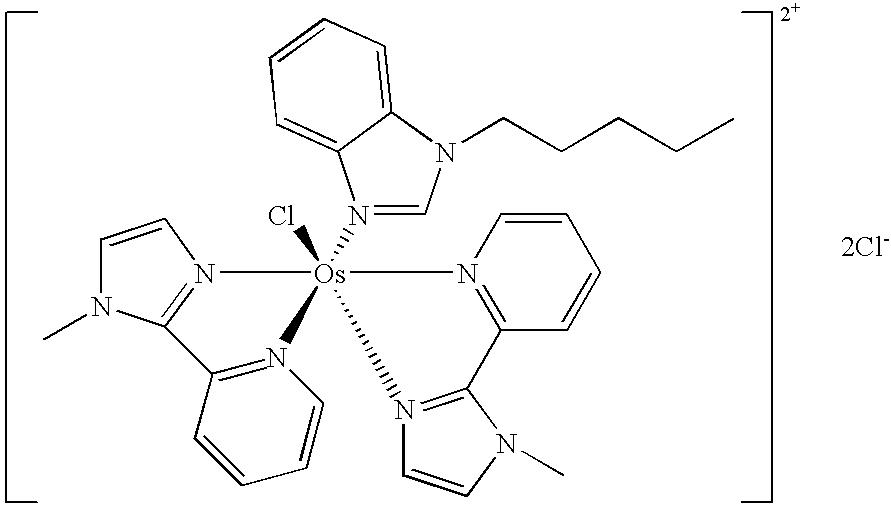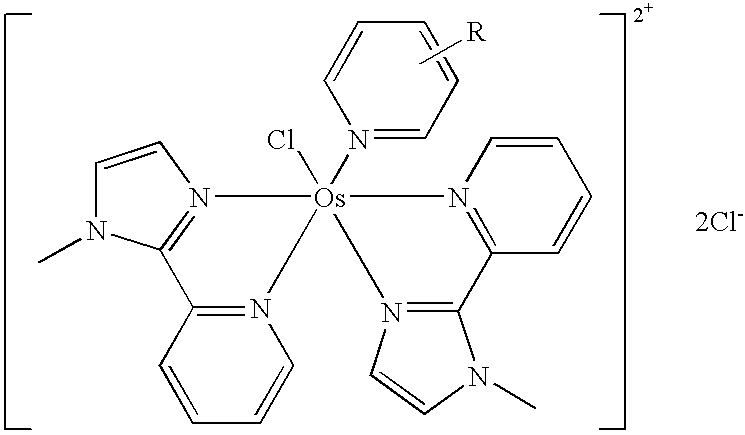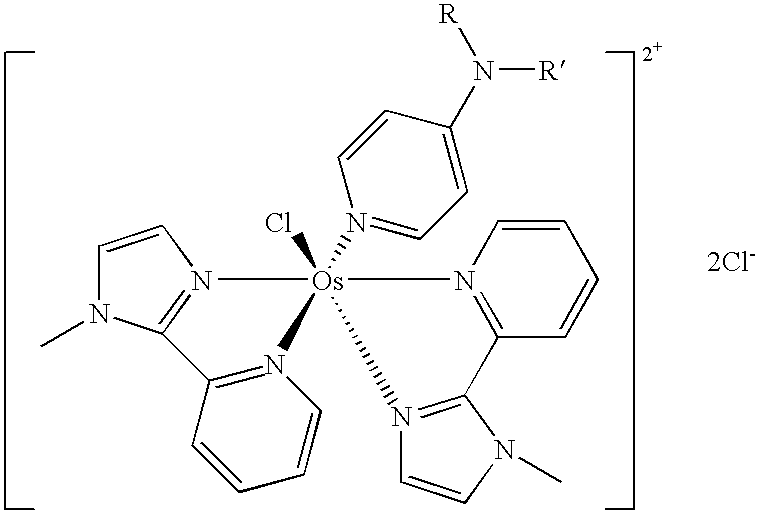Transition metal complexes with pyridyl-imidazole ligands
a technology of transition metal complexes and pyridylimidazole, which is applied in the field of enzymo-based electrochemical sensors comprising transition metal complexes with pyridylimidazole ligands, can solve the problems of low solubility of redox mediators in test solutions, limiting the enzymatic reaction of oxygen, and poor chemical, light, thermal and/or ph stability. to achieve the effect of facilitating
- Summary
- Abstract
- Description
- Claims
- Application Information
AI Technical Summary
Benefits of technology
Problems solved by technology
Method used
Image
Examples
example 1
Synthesis of [Os(Py-MIM)2(X)Cl]2+2Cl− Complexes
[0092]By way of illustration, examples of the syntheses of [Os(Py-MIM)2(MAP)Cl]2+2Cl− (“MAP”) and [Os(Py-MIM)2(MIM)Cl]2+2Cl− (“MIM”) as illustrated below, are now provided. As described herein, [Os(Py-MIM)2(MAP)Cl]2+2Cl+ is a transition metal complex that is particularly useful as a redox mediator.
Synthesis of 2-(1H-imidazol-2-yl)pyridine (=pyridyl-imidazole)
[0093]A solution of pyridine-2-carboxaldehyde (151.4 g, 1.41 mol) and glyoxal (40% in H2O, 205 mL, 1.79 mol) in 300 mL of ethanol (EtOH) in a three-neck 1 L round-bottom flask fitted with a thermometer and an addition funnel was stirred in an ice bath. When the solution was cooled to below 5° C., concentrated NH4OH (28-30%, 482 mL, 3.93 mol) was added dropwise through the addition funnel. The rate of the addition was controlled so that the temperature of the solution was maintained at below 5° C. After the addition, the stirring of the solution was continued in the ice bath for one ...
example 2
Synthesis of [Os(pMOP-IM)2(biMIM)]3+3Cl−
[0107]By way of further illustration, an example of the synthesis of [Os(pMOP-IM)2(biMIM)]3+3Cl− (“Dimethoxy”), as illustrated below, is now provided. This example demonstrates how a substitution can be introduced into the Py-MIM ligand as a means of generating mediators that work with FAD-GDH.
Synthesis of 4-methoxy-2-(1H-imidazol-2-yl)pyridine
[0108]To a suspension of ammonium acetate (1.13 g, 14.6 mmol) in 0.2 mL water at 45° C. with mechanical stirring in air, was added a suspension of 4-methoxypyridine carboxaldehyde (Milestone, 0.50 g, 3.65 mmol), glyoxal (40%, 0.50 mL, 4.38 mmol), and 0.87 mL ethanol portionwise over 2.5 h. Rinsed with 0.15 mL ethanol to complete the addition, and stirred a further 30 min at 45° C., then at room temperature overnight. Added 8 mL water, then filtered through Celite. To the filtrate was added dropwise with stirring, 1.4 mL 10% NaOH, then 0.43 g Na2CO3. Extracted with chloroform (3×10 mL), and washed the com...
example 3
Synthesis of 2-(1-phenyl-1H-imidazol-2-yl)pyridine (Py-PIM)
[0112]By way of further illustration, an example of the synthesis of 2-(1-phenyl-1H-imidazol-2-yl)pyridine, as illustrated below, is now provided. This example demonstrates how a 1-aryl-substituted 2-(2-pyridyl)imidazole is made from 1-(2-pyridyl)imidazole or its derivative, and an iodobenzene derivative (as illustrated) or a bromobenzene derivative.
[0113]2-(1H-imidazol-2-yl)pyridine (6.91 g), iodobenzene (11.47 g), Cs2CO3 (25 g), and copper powder (15 g) were combined in 60 mL anhydrous DMF in a 250 mL round bottom flask equipped with a magnetic stirrer and a reflux condenser. The mixture was degassed with N2 for 15 minutes at room temperature and then refluxed under N2 in an oil bath for 24 hours. The resulting mixture was cooled to room temperature and suction-filtered to remove the solid byproduct. The filtrate was extracted with EtOAc (3×100 mL). The combined organic layers were washed with H2O (2×100 mL), then with sat...
PUM
| Property | Measurement | Unit |
|---|---|---|
| volume | aaaaa | aaaaa |
| concentration | aaaaa | aaaaa |
| temperature | aaaaa | aaaaa |
Abstract
Description
Claims
Application Information
 Login to View More
Login to View More - R&D
- Intellectual Property
- Life Sciences
- Materials
- Tech Scout
- Unparalleled Data Quality
- Higher Quality Content
- 60% Fewer Hallucinations
Browse by: Latest US Patents, China's latest patents, Technical Efficacy Thesaurus, Application Domain, Technology Topic, Popular Technical Reports.
© 2025 PatSnap. All rights reserved.Legal|Privacy policy|Modern Slavery Act Transparency Statement|Sitemap|About US| Contact US: help@patsnap.com



